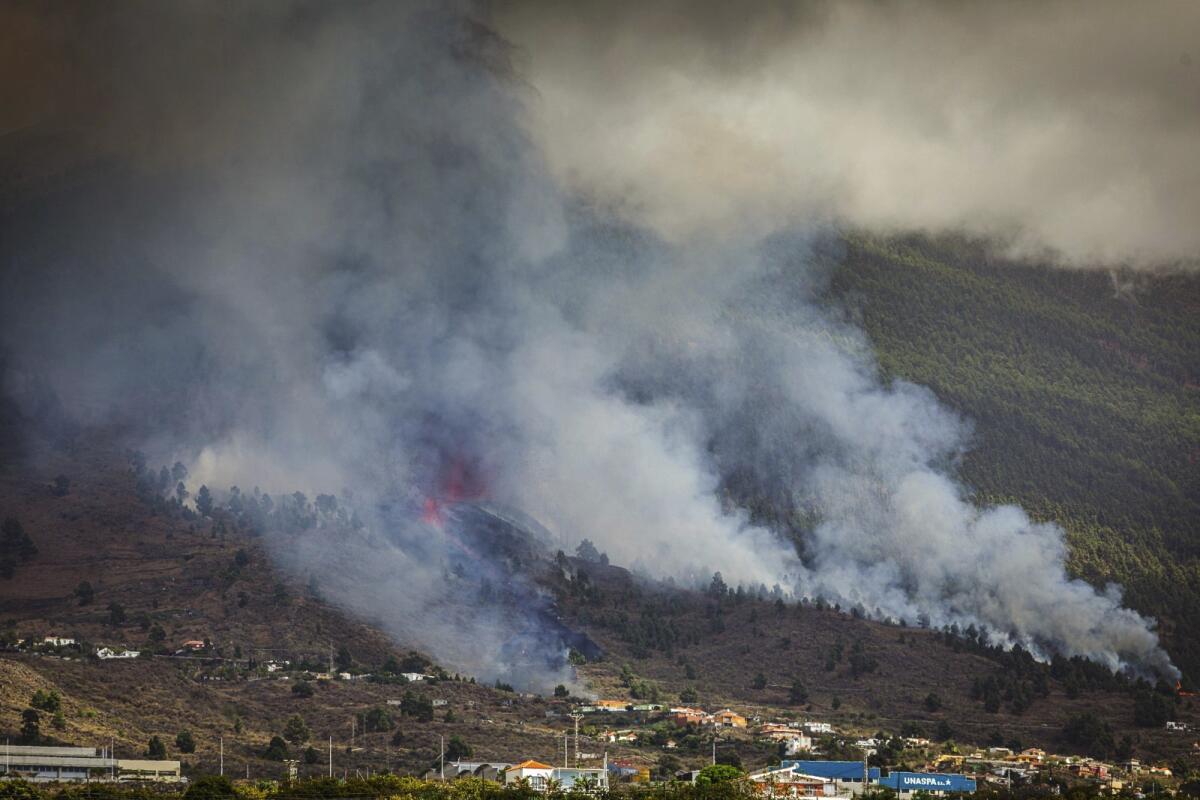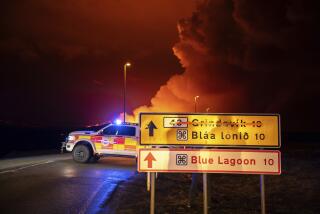Volcano erupts on Atlantic island; lava threatens some homes

- Share via
MADRID — A volcano on Spain’s Atlantic Ocean island of La Palma erupted Sunday after a weeklong buildup of seismic activity, prompting authorities to speed up evacuations for 1,000 people as lava flows crept toward isolated homes on the mountain.
The Canary Islands Volcanology Institute reported the eruption on Cumbre Vieja, which last erupted in 1971. Huge red plumes topped with black-and-white smoke shot out along a volcanic ridge that scientists had been closely watching following the accumulation of molten lava below the surface and days of small earthquakes.
Mariano Hernández, the president of La Palma island, told Canary Islands Television there were no immediate reports of injuries or deaths from the eruption. He said there were five eruption points, of which two were spewing magma.
The explosion took place in an area known as Cabeza de Vaca on the western slope of the volcanic ridge as it descends to the coast. Tinges of red could be seen at the bottom of the black jets that shot rocks into the air.
The patient, a resident of the county’s eastern region, was hospitalized and died from a neuro-invasive disease associated with the virus, officials said.
One black lava flow with a burning tip was sliding toward some houses in the village of El Paso. Mayor Sergio Rodríguez said 300 people in immediate danger had been evacuated from their homes and sent to the El Paso soccer field. Roads were closed due to the explosion and authorities urged the curious not to approach the area.
La Palma, with a population of 85,000, is one of eight islands in Spain’s Canary Islands archipelago off Africa’s western coast. At their nearest point to Africa, they are 60 miles from Morocco.
Itahiza Dominguez, head of seismology of Spain’s National Geology Institute, told local TV station RTVC that although it was too early to tell how long this eruption would last, prior “eruptions on the Canary Islands lasted weeks or even months.”
The last eruption on the Canary Islands occurred underwater off the coast of El Hierro island in 2011. That eruption last five months.
Spanish Prime Minister Pedro Sánchez canceled his trip to New York to attend the U.N. General Assembly so he could travel from Spain’s mainland to the Canary Islands archipelago.
After days of what scientists call an “earthquake swarm,” authorities on La Palma had already started to evacuate residents with reduced mobility Sunday shortly before ground broke open. The area near the southern tip of the island where the ridge is located is not densely populated. Residents of the five nearby villages had already been told to be on alert and ready to leave their homes in case of an eruption.
A 3.8-magnitude quake was recorded before the eruption as vibrations from the seismic activity were felt on the surface.
The Scientific Committee of the Volcano Risk Prevention Plan said stronger earthquakes “are likely to be felt and may cause damage to buildings.” The committee of experts also noted that a stretch of the island’s southwest coast was at risk for landslides and rock falls.
More to Read
Sign up for Essential California
The most important California stories and recommendations in your inbox every morning.
You may occasionally receive promotional content from the Los Angeles Times.











